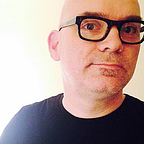Alfred Hitchcock, George Rouault and the Curious Case of The Wrong Man
For years, critics and biographers glommed onto Alfred Hitchcock’s strict Jesuit education as a key to understanding his films. His favorite themes of crime and punishment, guilt and innocence were all imprinted on him at the end of those priests’ punishing leather strops. Then the tide turned. Today, most writers soft-pedal the influence that religion may have had on his work. (As an adult, he rarely went to church, and at times expressed an ambivalent view of religion in general.) Curiously, two of his films that explicitly dive into Catholic themes—I Confess (1953) and The Wrong Man (1956)—are largely overlooked—at least at the film festival level. In the spirit of what-goes-around-comes-around, I’d like to approach that second film from a more nuanced perspective. It ain’t hard to draw a connection between Hitch’s equivocal relationship with the church and the ironic way it’s treated in The Wrong Man.
There’s a little bit of Catholicism in most of Hitch’s films
Even if at times it isn’t much more than an Ash Wednesday smudge. As such, it’s easy to say that he belonged to the 20th century’s small handful of Catholic modern artists — a very short list that also included Graham Greene (with whom he’d tried to work) and Expressionist French painter Georges Rouault. Hitch deeply appreciated the painter, once telling his friend and biographer Charlotte Chandler that he considered it a privilege to be able to afford a Rouault, which occupied pride of place in the foyer of Hitchcock’s Bel-Air road home.
Hitch must have seen the painter as a kindred spirit. Both artists dealt repeatedly with the same narrow list of subjects. Said the director to Truffaut: “Not that I’m comparing myself to him, but old Rouault was content with judges, clowns, a few women, and Christ on the Cross.” More or less, those same types keep popping up in Hitchcock’s films as well. Curious, isn’t it?
The Wrong Man could almost be subtitled “Variations on a Theme by Rouault.” The story is about an everyman, a New York-bred Italian Catholic from Queens—one Christopher Manuel Balastrero (Henry Fonda)—who’s wrongly accused of committing a series of robberies. In a case of mistaken identity, he’s arrested and put through the legal system as if compelled to hit the road to Golgotha. The film takes viewers in detail through the humiliation of his arrest, fingerprinting and incarceration, ending with the clang of the prison door as it shuts over him — a sequence that fairly imitates a the Stations of the Cross.
A Christ figure, he carries the sins of another, and the movie goes out of its way to draw connections between Manny, whose proper names — Christopher Manuel — evoke Christ, while his nickname riffs on his humanity, or manhood — wordplay that Hitch wouldn’t have missed.
During the early years when Rouault was developing his own voice, he became friends with Catholic writer Léon Bloy, whose novels Le Désespéré (The Desperate,1887) and La Pauvre (The Poor, 1897) deeply affected the painter. Bloy was concerned with suffering, redemption and the rejection of the sordidness of this world, writing, “I have meditated long and often on suffering, I am now convinced that nothing else is supernatural in this world. All the rest is human.” Thoughts on the transcendent nature of suffering were expressed by Rouault through his painting — and they approximate Hitchcock’s sentiments in this film as well.
The Wrong Man is one of Hitch’s less-well-known masterpieces. Of all his films, it’s the one that most forsakes humor to remain grindingly bleak in its realism—and better for it. I’d like to leave you with a thought from art scholar Joshua Kind, who described Rouault’s worldview this way:
“He is perhaps existential; his world is that of suffering and melancholy. … Rarely if ever does [he escape] into a really savage renunciation of self and world — and yet it speaks with a quiet despair of the human condition.”
To watch The Wrong Man, you’d think Joshua Kind was also talking about Hitchcock.
Support my work on Patreon.
If you’re a Hitchcock fan or just a movie nerd, you might be excited to know that I’m now creating a web series called Alfred Hitchcock Geek. Integrating film sequences, rare behind-the-scenes clips and interviews with Hitch himself, I’m doing my part to bring Hitchcock studies into the 21st century. Check it out and, if you like what you see, I’d be honored to receive your support!
Originally published at www.alfredhitchcockgeek.com.
